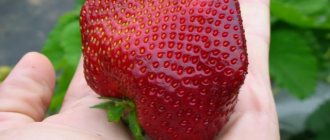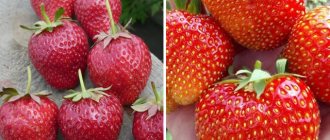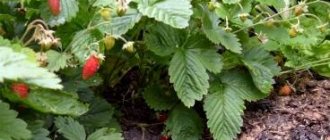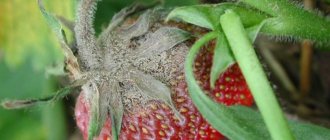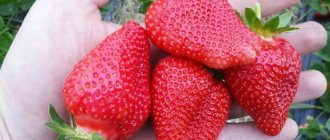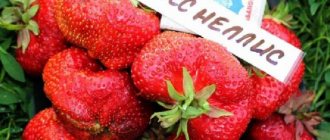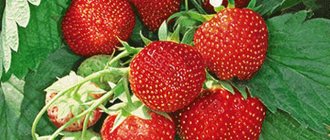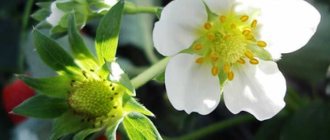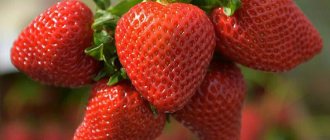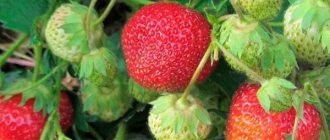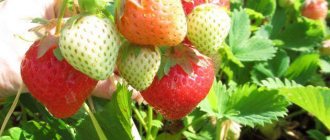According to most gardeners, strawberries are a fastidious berry and require a lot of effort to grow good fruits. But today such an opinion can be easily refuted, since breeders have developed many varieties of strawberries that are distinguished by their unpretentiousness and good yield. One of these is the Elephant variety. The description of the strawberry variety Slonenok, photos and reviews of summer residents and gardeners who grow this plant confirm its uniqueness. Winter hardiness, unpretentiousness and high yield make it possible to grow strawberries of this variety even if there is no experience in growing such berry crops.
Description of the strawberry variety Elephant
Strawberries of the Slonenok variety are not a remontant species; in terms of fruit ripening, they are classified as medium. The bushes of the plant are powerful and erect. They have abundant, small, dark green foliage with a silvery tinge. The shape of the leaves is oval-rhombic, slightly concave. The edges of the leaves are jagged, the teeth are blunt and narrow. Whiskers are formed in medium quantities, their color is light pink. The inflorescence is semi-spreading and multi-primed. The flowers are bisexual, small in size, cream and white.
The fruits of the Baby Elephant strawberry are quite large, weighing from 10 to 40 g. The largest berries occur at the beginning of the picking season - in mid-June; towards the end, the size of the fruit decreases, which indicates unstable fruiting.
The berry is rich red in color with a glossy sheen. The shape is ovoid, sometimes forked, without a neck. The pulp is dense without voids, red with a pleasant rich strawberry aroma. The taste feature can be considered a pronounced sourness against the background of sweetness; sometimes the fruits have a moderate sweet and sour taste. Suitable for any type of consumption: both raw and processed (in jam, jam, compote). But, despite its versatility, it is recommended to grow this berry for personal consumption. It is rarely used for commercial purposes, since the harvest is formed only once per season.
How to care
Strawberries of the Elephant variety love moisture, so watering should be regular and plentiful. You need to moisten the soil 5-6 times a month. It is best to use a drip irrigation system. About 12 liters of water will be needed per 1 m2. It is best to use warm liquid. How Clery strawberries are watered and how this variety is fertilized is described in detail in this article.
Mulching
To avoid constant watering, it is worth mulching or loosening the soil. In addition, it is an excellent prevention against weed formation. For mulching, you should use straw or sawdust. Mulch should be removed late in the fall and burned immediately. The fact is that this material can cause the development of various diseases.
Pros and cons of the Elephant variety
Bred by breeders from the Siberian Research Institute, the relatively young strawberry variety Elephant has many positive qualities:
- unpretentiousness of the plant in care;
- high yield rates;
- large-fruited harvest;
- pleasant sour-sweet taste of fruits with a delicate strawberry aroma;
- fairly high level of frost resistance.
But like any type of plant, this strawberry also has a number of disadvantages:
- due to high humidity, rot often appears on this type of plant;
- high yield and berry size directly depend on fertilizing and the frequency of watering;
- the pulp is too dense, practically without juice.
Although the positive quality of the Elephant variety is its unpretentiousness in care, improper cultivation, watering and fertilizing can have a detrimental effect on the future harvest.
Main characteristics
Let's look at the most important characteristics of the variety in the table:
| Parameter | Characteristic |
| Culture | Strawberry (Fragaria L.) |
| Ripening time | Average |
| Fruiting | One-time (non-repairable) |
| Photoperiodic type | Short daylight hours |
| Productivity | On average 71.3-87.3 c/ha |
| Mass of berries | 10-30 g |
| Fruit shape | Broadly ovate, without neck |
| Berry color | Red, glossy |
| Pulp | Red, juicy, tender |
| Tasting assessment | 4.5-4.7 points (out of 5) |
| Purpose | Universal |
| Flowers | Medium size, white and cream, bisexual, twisted |
| Educational ability | Medium (mustache pale pink) |
| Sustainability | High winter hardiness; weakly affected by diseases and pests |
| Region of admission | West Siberian, East Siberian |
| Year of inclusion in the Federal State Budgetary Institution "State Varietation Commission" | 2006 |
| Originator | Federal State Budgetary Institution "Federal Altai Scientific Center of Agrobiotechnologies" (Barnaul) |
Planting and caring for strawberries Baby Elephant
Planting strawberry seedlings Baby Elephant can be done in spring or autumn. In particular, it is recommended to plant strawberries in the autumn, so they will fully strengthen before winter and gain strength for fruiting.
Selection and preparation of a landing site
A strawberry bed for this variety should be arranged in a sunny place protected from the winds. In addition, it is advisable to choose a planting site on an elevated area, since moisture accumulates in the lowlands, and this is detrimental to this strawberry.
It is best to arrange a garden bed on a piece of land where legumes, radishes or cucumbers previously grew. But the land where asteraceous plants grew is not suitable for planting. It is best to wait at least 4 years, only then prepare the soil for setting up a bed for baby elephant strawberries.
Important! A month before planting, the soil should be fertilized with ammonium nitrate.
Adding ammonium nitrate to the soil allows you to maximally prepare it for the subsequent formation and strengthening of strawberry seedlings. After 2 weeks of applying nitrate, the soil needs to be dug about 30 cm deep and fertilized with an organic compound (humus or compost), and also add potassium chloride and superphosphate.
Preparation of planting material
For planting, seedlings with a well-formed root system should be selected. If you plan to purchase seedlings, it is best to do this from a trusted supplier or a specialized nursery.
The seedlings should have a healthy appearance, not flaccid and have dark green leaves with a bluish bloom. The seedling must have at least 3 well-developed full leaves. The length of the central root can vary from 5 to 10 cm; if it is longer, the root should be cut off.
Advice! Before planting, the root should be soaked in a special solution to stimulate growth or in regular warm water.
Landing rules
If a place for the garden bed has been chosen and all work has been done to fertilize the soil, you can begin planting the seedlings. It is recommended to plant strawberry seedlings Baby Elephant in the evening or when it is cloudy outside. This is necessary so that young planted bushes do not get too much sunlight.
As a rule, holes for seedlings are made in a row. There should be a distance of at least 20 cm between the holes in a line, and up to 80 cm between the rows.
Before planting, the deep holes must be filled with warm water. Then the seedlings are planted and the soil is compacted around their roots. After planting, it is better to mulch with peat or humus.
Watering and fertilizing
Strawberries themselves are moisture-loving plants. But it is worth remembering that the Elephant variety does not like heavy waterlogging, as this can lead to the appearance of gray rot. Therefore, the beds should be watered regularly, but in moderation. Basically, the soil should be moistened at least 5 times per month.
For Strawberry Baby Elephant, a drip irrigation system is most suitable. It is not recommended to excessively wet the leaves and stems of bushes, especially during flowering and fruiting.
Important! Strawberries should be watered with warm water in the evening.
In addition to regular watering, feeding the plant also affects the size of the future harvest. Since the Baby Elephant strawberry is large-fruited, it needs to be fed with fertilizers at least 3 times per season.
In spring, it is best to give preference to mineral complexes with a high content of nitrogen, potassium, phosphorus and magnesium. This additive will promote the growth and development of strawberry bushes, strengthening their root system and root formation. But you should not allow the whiskers to grow too much, otherwise the berry will be small. To prevent such a situation, it is necessary to trim the whiskers that are not required for further reproduction.
During the fruiting period and autumn, it is best to use organic fertilizers (humus, compost, wood ash).
Mulching and loosening
Many gardeners resort to mulching strawberry beds. In this way you can significantly reduce the number of waterings. Organic materials such as straw and sawdust are most often used as mulch. Sometimes they resort to inorganic materials - plastic film, roofing felt.
Mulching prevents the rapid evaporation of moisture, thus the soil in the garden bed remains moderately moist, which is very important for the Elephant variety. This procedure is also important for weed control. A protective layer of mulch prevents sunlight from reaching the areas between strawberry bushes, which slows down the growth of weeds.
Before laying a layer of mulch, be sure to loosen the soil. This will enrich the soil with oxygen and immerse all the nutrients for the strawberry root system to the required depth.
Preparing for winter
Preparing strawberries Baby Elephant for winter should begin in August. This month it is necessary to remove the mulch, if it has been laid, loosen, water and fertilize the soil with organic fertilizer. It is best to burn the mulch - this will help get rid of possible bacteria and viruses.
During the same period, leaves are cut off if they look unhealthy. The leaves should be cut with pruning shears and then treated with karbofos to completely destroy the pests. After cutting the tops, they must be collected in a heap and burned.
Important! After this operation, strawberries must be fed with fertilizers with a high nitrogen content so that the plant can grow new young leaves.
At the end of autumn, you should mulch the strawberry beds with pine needles. This mulch will allow the bushes to breathe and prevent the growth of bacteria.
Harvesting
According to the description and photo of the strawberry variety Slonenok, as well as reviews from gardeners, the fruiting period completely depends on the care and growing region. It mainly varies from late May to late June.
At the beginning of ripening, the berries are larger, sometimes the fruits can reach up to 40 g. And closer to the end of fruiting, the size of the berries decreases.
If you plan to collect strawberries directly for consumption or for winter storage, preference should be given only to ripe berries. They should have a uniform red color with a slight gloss. An exception may be the transportation of crops. Then the berries are harvested slightly unripe.
The berry must be collected with the calyx and stalk. To preserve the appearance as much as possible, it is best to cut the fruit from the bush using garden shears.
After harvesting the first crop from the bushes, you should check the beds every 2 days and remove the berries as they ripen.
Reviews
- Elena, 35 years old: “The Elephant variety adapts perfectly to different climate conditions. One year we had a very rainy summer, but my bushes did not rot and bore fruit well. The yield of the variety is also quite high, because from one bush you can get up to 2.5 kg. The berries are dense, but juicy. They can be stored in the refrigerator for up to 4-5 days, without losing their appearance or taste.”
- Marina, 48 years old: “I have had a Baby Elephant growing in my dacha for 4 years now. I would like to highlight such a feature of the variety as early fruiting. You can get the first harvest already in the year of planting. I planted seedlings in the fall, but in the spring I was able to harvest 0.5 kg of strawberries from one bush. The berries are large and juicy, but this is only if the tendrils are removed in time and the bushes are planted. If there is thickening, the fruits become small and begin to lose their former appearance.”
And although Slonenok is a non-repairing strawberry variety, due to its high yield it is possible to obtain a sufficient number of berries during the entire fruiting period. In addition, the fruits are large in size and marketable. They can be used at home and for sale. Do not forget that berries can be stored for a long time without losing their taste and appearance.
Reproduction
Strawberry Elephant propagation can be done in several ways:
- mustache;
- division of roots;
- seeds.
The most common and favorite method for many gardeners is propagation by mustache. Since strawberry Baby Elephant does not have a lot of whiskers, the whiskers should be immediately used for propagation or removed. This allows you to increase productivity.
For propagation, the first formed rosettes on the tendrils from the mother bush are considered ideal. Whiskers of the second and third order are also suitable for propagation, but in terms of the size of the formed root system they are much smaller. The mustaches following them must be removed so that the mother bush does not waste its energy on their growth.
When the first roots appear on the mustache, they should be placed in a separate pot or plastic glass with previously prepared fertilized soil. There is no need to separate the mustache from the mother bush.
When propagating strawberries by dividing the bushes, a 3-year-old plant should be selected. Just at this age, the strawberry has a well-formed trunk, and it is located at ground level. The bush is dug up and divided into horns. The already separated horn is transplanted to a new place. This breeding should be done in early August. They resort to it only when absolutely necessary, since this transplantation for strawberries is very stressful.
Video
An experienced gardener shares his success in growing the “Slonenok” variety in the Moscow region in the following videos:
About the author:
Found a mistake? Select the text with the mouse and click:
Ctrl + Enter
Do you know that:
One of the most convenient methods for preparing a harvest of vegetables, fruits and berries is freezing. Some believe that freezing causes the nutritional and health benefits of plant foods to be lost. As a result of the research, scientists have found that there is practically no decrease in nutritional value when frozen.
